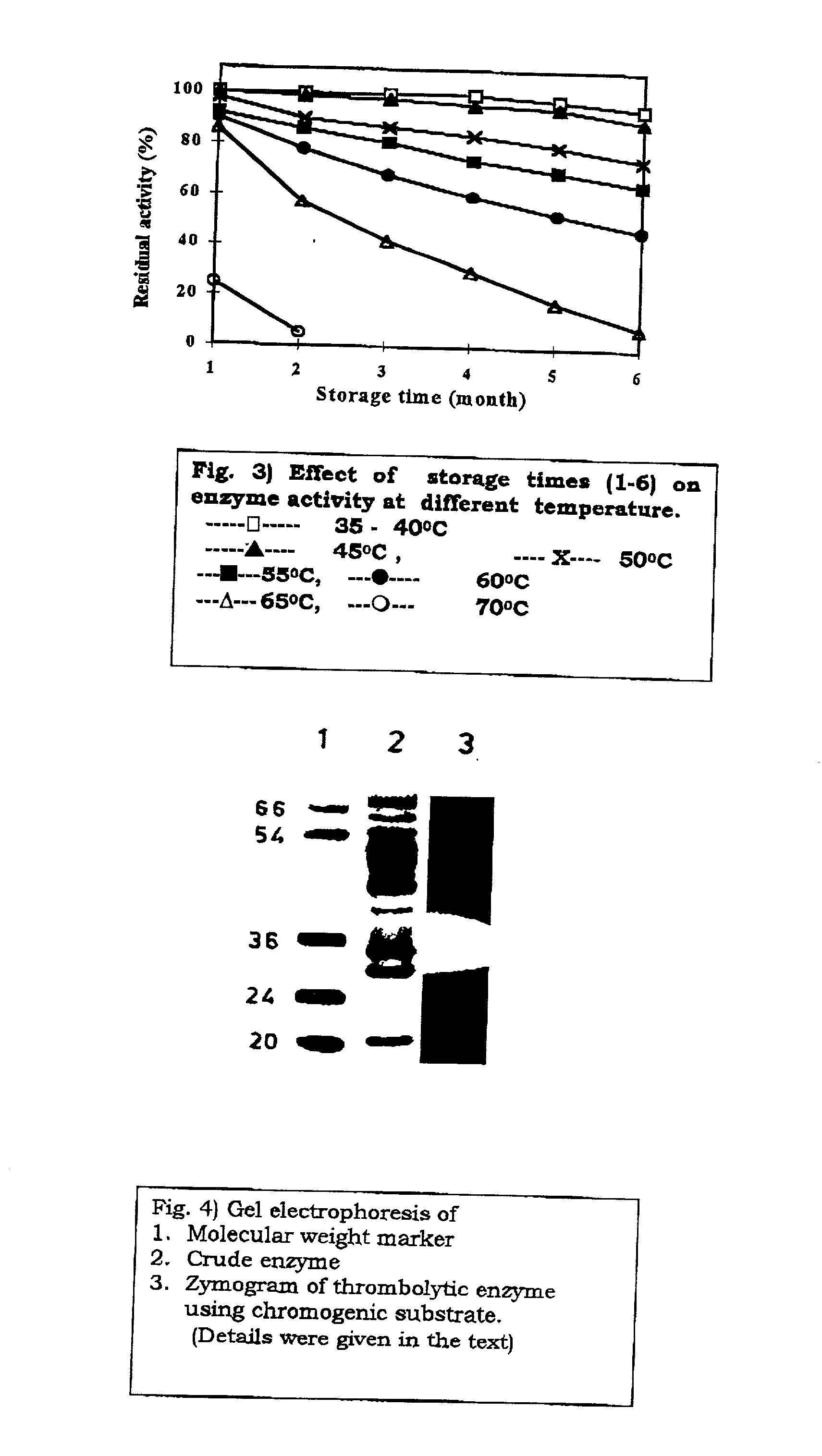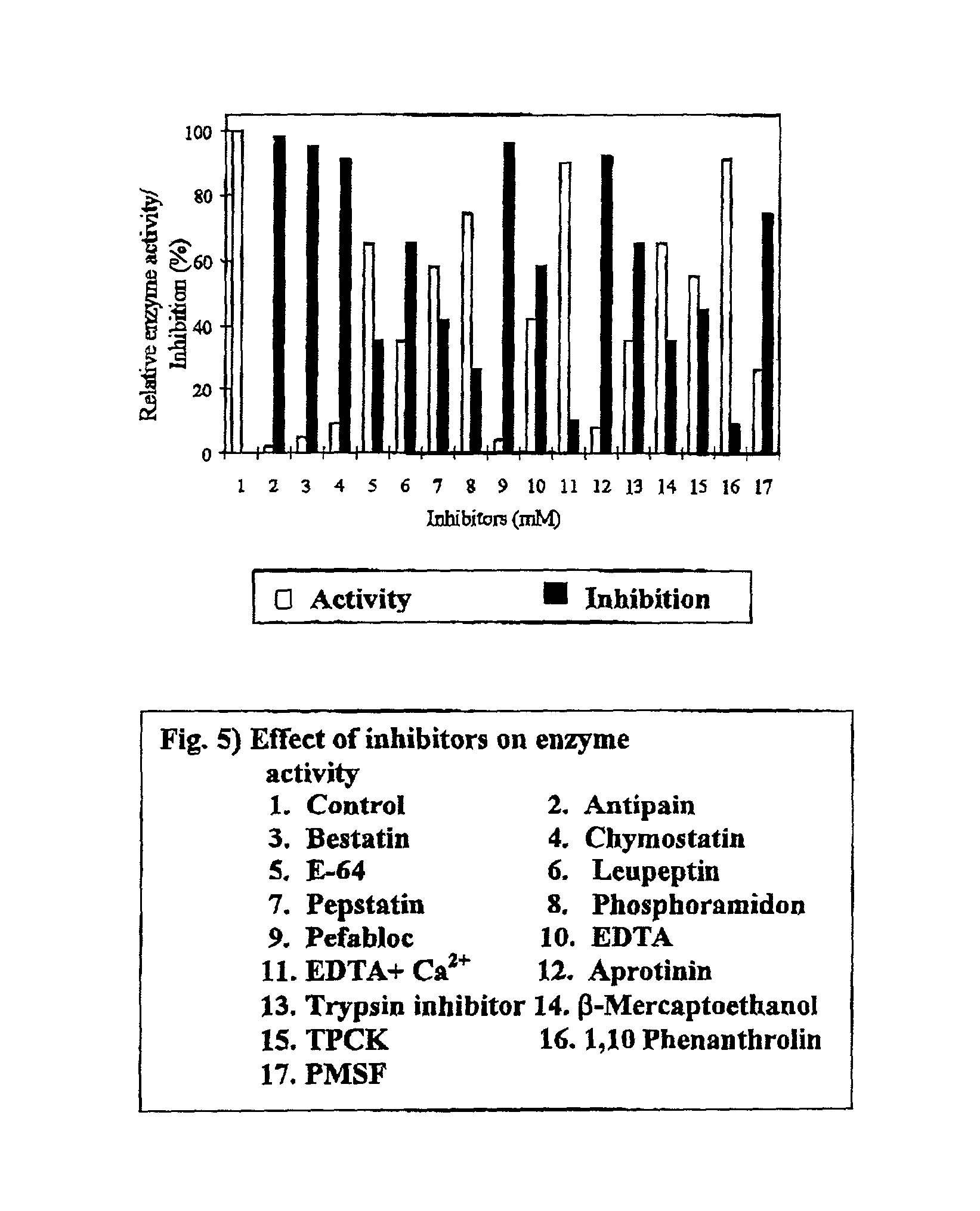Streptomyces megasporus sd5, process for the isolation thereof, novel fibrinolytic enzyme prepared therefrom, process for the production of said enzyme and method of treatment of thrombolytic disorders using said enzyme
a technology of fibrinolysis and process, which is applied in the field of process for the production of fibrinolysis enzyme, which can solve the problems of high failure rate, high cost of streptokinase, and high cost of enzymes, and achieves better resistance to ph the enzyme, reduced activity, and strong producer
- Summary
- Abstract
- Description
- Claims
- Application Information
AI Technical Summary
Benefits of technology
Problems solved by technology
Method used
Image
Examples
example 2
[0218] Streptomyces megasporus SD5 isolate was grown in GYP medium (glucose / yeast extract / peptone), pH 8.0 and maintained as spore suspension at -70.degree. C. in the presence of 25% glycerol; a cryoprotectant (Hopwood et al 1985). For production of the enzyme, 100 .mu.l of spore suspension was inoculated in 100 ml of sterile GYP medium, pH 8.0, containing (% w / v) glucose--1, yeast extract--0.5, peptone--0.5, NaCl--0.5 and CaCl.sub.2--0.02 in a 500 ml Erlenmeyer flask and incubated for 18 h at 55.degree. C.
[0219] After cooling to room temperature the cells were harvested by centrifugation at 10000 g for 8 min and the spent broth was filtered through a 0.22.mu. membrane to remove the spores. Filtrate was concentrated by precipitating with 80% saturation of ammonium sulphate, dialysed and used as crude enzyme solution.
[0220] A strong fibrin-specific fibrinolytic enzyme was purified from the cell-free spent culture broth. The strain produced 150 mg crude protein l.sup.-1 of spent broth...
example 3
[0237] Production of the Fibrinolytic Enzyme Using S. megasporus SD5
[0238] Preparation of Seed Culture
[0239] After optimisation of the fibrinolytic enzyme at flask level, preparation of the seed culture was carried out. To prepare the seed culture, GYP medium, pH 8.0 (50 ml) containing 0.02% CaCl.sub.2 was inoculated with 50 .mu.l of spore suspension and incubated at 55.degree. C. for 10 h and the resultant growth was used to inoculate 500 ml fresh pre-warmed (55.degree. C.) GYP medium followed by incubation at 55.degree. C. for 10 h.
[0240] Bench Scale Production of the Enzyme
[0241] In a laboratory scale (10 l) fermenter (MDL Marubishi, Japan) 5 l prewarmed medium (55.degree. C.) was inoculated with 500 ml seed culture grown as mentioned earlier and incubation was continued for 18 h at 55.degree. C. with agitation (150 rev min.sup.-1) and aeration (400 ml min.sup.-1). The fermented broth was cooled to room temperature and the density of the viable cells was determined. The cell mass...
example 4
[0245] Bacterial Strain and Culture Medium
[0246] Streptomyces megasporus SD5 was isolated from tectonic zone and identified to the cluster level. The medium used for culturing the strain consisted of (%w / v) glucose 1, yeast extract 0.5, peptone 0.5, NaCl 0.5 and CaCl.sub.2 0.2 with the pH being 8,0. The protein was collected from spent cell free broth after 18 hours of incubation at 55.degree. C. and concentrated by ionic precipitation followed by purification using standard protocol. The yield of protein was 150 mg per liter of broth with a specific activity of 80 Umg.sup.-1. In vitro study was carried out on the effects of actinokinase (0-100 .mu.ml.sup.-1) on the clotting time and the clot dissolution time using standard protocols.
[0247] The values obtained were compared with those of prior art enzymes. In vivo studies were carried out on rabbits after observing the immulogical responses of the wild and recombinant enzymes. The properties of the protein are given in Table X and t...
PUM
| Property | Measurement | Unit |
|---|---|---|
| temperature | aaaaa | aaaaa |
| temperature | aaaaa | aaaaa |
| temperature | aaaaa | aaaaa |
Abstract
Description
Claims
Application Information
 Login to View More
Login to View More - R&D
- Intellectual Property
- Life Sciences
- Materials
- Tech Scout
- Unparalleled Data Quality
- Higher Quality Content
- 60% Fewer Hallucinations
Browse by: Latest US Patents, China's latest patents, Technical Efficacy Thesaurus, Application Domain, Technology Topic, Popular Technical Reports.
© 2025 PatSnap. All rights reserved.Legal|Privacy policy|Modern Slavery Act Transparency Statement|Sitemap|About US| Contact US: help@patsnap.com



